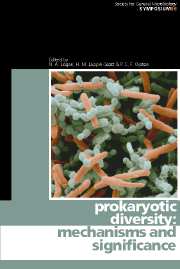Book contents
- Frontmatter
- Contents
- Contributors
- Editors' Preface
- Microbial diversity in the era of genomics
- Patterns in prokaryotic biodiversity
- A putative RNA-interference-based immune system in prokaryotes: the epitome of prokaryotic genomic diversity
- The significance of prokaryote diversity in the human gastrointestinal tract
- The genetics of phenotypic innovation
- Minimal genomes required for life
- Evolution of the core of genes
- Biogeographical diversity of archaeal viruses
- Is there a link between Chlamydia and heart disease?
- Unculturable oral bacteria
- Comparative genomics – what do such studies tell us about the emergence and spread of key pathogens?
- Spread of genomic islands between clinical and environmental strains
- Evolving gene clusters in soil bacteria
- Unusual micro-organisms from unusual habitats: hypersaline environments
- Genomic islands and evolution of catabolic pathways
- Horizontal gene transfer and its role in the emergence of new phenotypes
- Index
The genetics of phenotypic innovation
Published online by Cambridge University Press: 06 July 2010
- Frontmatter
- Contents
- Contributors
- Editors' Preface
- Microbial diversity in the era of genomics
- Patterns in prokaryotic biodiversity
- A putative RNA-interference-based immune system in prokaryotes: the epitome of prokaryotic genomic diversity
- The significance of prokaryote diversity in the human gastrointestinal tract
- The genetics of phenotypic innovation
- Minimal genomes required for life
- Evolution of the core of genes
- Biogeographical diversity of archaeal viruses
- Is there a link between Chlamydia and heart disease?
- Unculturable oral bacteria
- Comparative genomics – what do such studies tell us about the emergence and spread of key pathogens?
- Spread of genomic islands between clinical and environmental strains
- Evolving gene clusters in soil bacteria
- Unusual micro-organisms from unusual habitats: hypersaline environments
- Genomic islands and evolution of catabolic pathways
- Horizontal gene transfer and its role in the emergence of new phenotypes
- Index
Summary
EVOLUTIONARY EMERGENCE OF DIVERSITY
The majority of phenotypic and ecological diversity on the planet has arisen during successive adaptive radiations, that is, periods in which a single lineage diverges rapidly to generate multiple niche-specialist types. Microbiologists tend not to think of bacteria as undergoing adaptive radiation, but there is no reason to exclude them from this general statement – in fact, rapid generation times and large population sizes suggest that bacteria may be particularly prone to bouts of rapid ecological diversification. Indeed, there is evidence from both experimental bacterial populations (Korona et al., 1994; Rainey & Travisano, 1998) and natural populations (Stahl et al., 2002). This being so, insight into the evolutionary emergence of diversity requires an understanding of the causes of adaptive radiation.
The causes of adaptive radiation are many and complex, but at a fundamental level there are just two: one genetic and the other ecological. Put simply, heritable phenotypic variation arises primarily by mutation, while selection working via various ecological processes shapes this variation into the patterns of phenotypic diversity evident in the world around us.
The ecological causes of adaptive radiation are embodied in theory that stems largely from Darwin's insights into the workings of evolutionary change (Darwin, 1890), but owes much to developments in the 1940s and 1950s attributable to Lack (1947), Dobzhansky (1951) and Simpson (1953). Recent work has seen a reformulation of the primary concepts (Schluter, 2000).
- Type
- Chapter
- Information
- Prokaryotic DiversityMechanisms and Significance, pp. 91 - 104Publisher: Cambridge University PressPrint publication year: 2006
- 3
- Cited by

